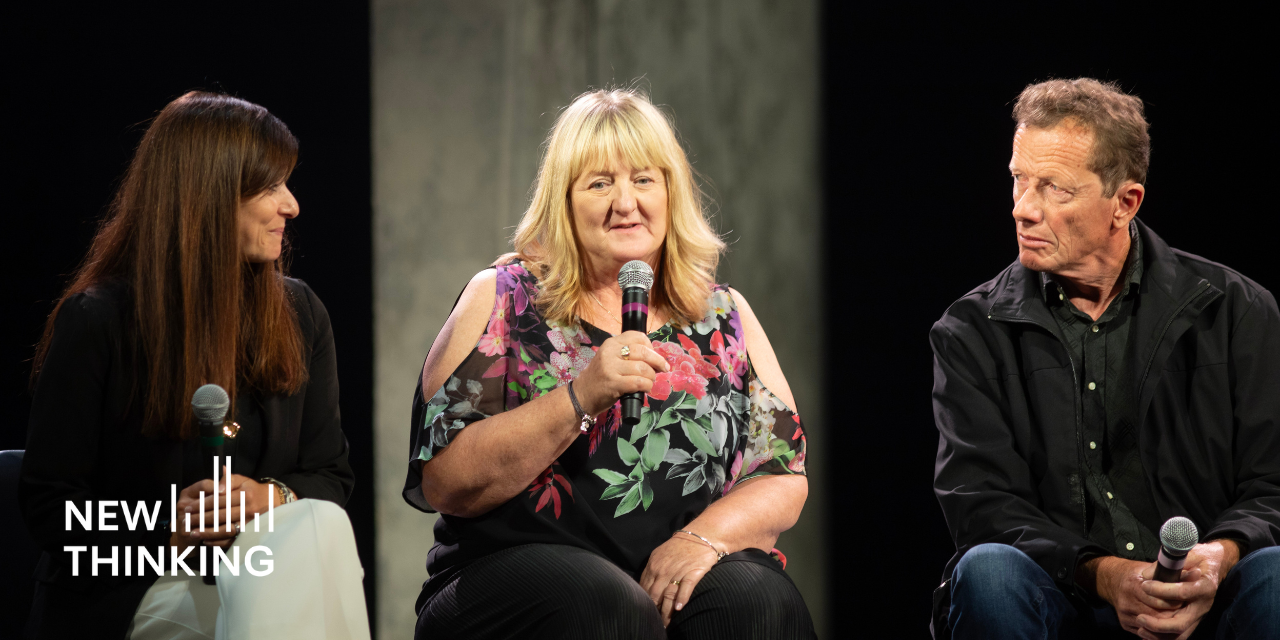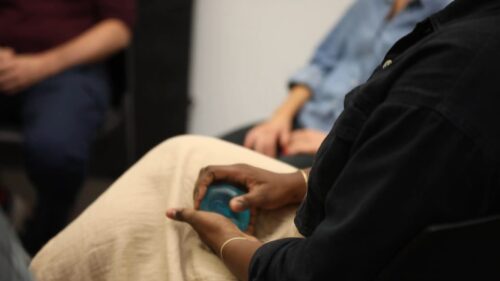John Chisholm, district attorney of Milwaukee County, Wisconsin, joins the New Thinking podcast to discuss community prosecution, diversion, and his work to reduce mass incarceration and racial inequities in the justice system.
The following is a transcript of the podcast:
Raphael POPE-SUSSMAN:
Hi, this is Raphael Pope-Sussman with the Center for Court Innovation. And today, I’m speaking with John Chisholm, who has served as district attorney for Milwaukee County in Wisconsin, since 2007. Chisholm has attracted national attention for his work to reduce mass incarceration and racial inequities in the justice system. Recently, he was profiled by Jeffrey Toobin in The New Yorker. John, thank you for speaking with me today.
John CHISHOLM:
Raphael, glad to be here.
Raphael POPE-SUSSMAN:
So when you were running for district attorney, were you thinking about how you would approach over-incarceration and racial imbalances in the justice system?
John CHISHOLM:
You know, that’s not what actually drove it initially. While I was running, we were experiencing some deep unrest and dissatisfaction based on a fairly high-profile incident of police misconduct involving the beating of an African-American citizen here in Milwaukee. And coming out of that, there was from my perspective, a need to reach out to the community and engage them in their perceptions of whether or not they were treated fairly in the system.
Now, at the same time I had been fortunately working with the Vera Institute in New York, where they had proposed earlier the concept of coming into our office, and analyzing what we did on a daily basis. And looking first and foremost, at whether the issue of what we charged on a daily basis was contributing to any disproportionality or disparity within the jail system or the prison system.
POPE-SUSSMAN:
And can you talk a bit about what they found?
CHISHOLM:
I certainly can. So they came in and their first finding was on the firsthand positive, and that they found that at least on our initial review and issuance of cases, that there was no discernible bias or disparity in our charge, no charge decisions.
What they did find however, and I think it was not a surprise to a lot of the people that had been in the system for a significant amount of time. Was that in certain categories of criminal offenses, there was fairly significant disparity. And the one that stood out the most was on the mid to lower-level drug offenses. And that certainly was matched by the disparity in the state prison system.
POPE-SUSSMAN:
And where did this disparity come from?
CHISHOLM:
Well, one of the first things they identified is that one of our lowest level offenses, something that we called possession of drug paraphernalia, which was one of the lowest classes of misdemeanor, had one of the highest disparity rates. And as we started analyzing it, they said, look, there doesn’t look like there’s any apparent bias. But what we found is that, our least experienced prosecutors who were reviewing the cases, oftentimes, the individuals who were drug-addicted had multiple, multiple misdemeanors, and sometimes even felony drug-related cases.
And what you were finding is that, the initial reviewer would simply say, look, the guy’s got a terrible record. I almost can’t justify not charging it, even though I know it’s a relatively minor offense. And when you brought the senior people and they were like, why do we even charge these cases? I mean, people that are caught with drug paraphernalia are drug users, and drug users would be better off getting treatment than spending five, 10, 15 days in jail. That’s just one example that I could give you, that the data actually allowed us to step back from it and say, well, maybe there could be a policy change that says that our first inclination would be on a low-level case like this, that we’d rather divert that person into a treatment program. That’s just one example of how we started analyzing cases.
And from that moment on, what we did is we invited other institutions and academic entities to come in and assist us. So you brought experts in who gave you effective tools that you could use to identify the risks that individuals posed when they were brought into the system, and what their needs were. And then the next step was to talk to community stakeholders and system professionals and say, look, can’t we develop a system that would allow us to identify those people that we really think need a full system response? That would certainly be violent offenders, sex offenders, gun offenders, individuals that pose an immediate risk to the community.
The next group however, are those individuals that are coming in for a host of different reasons. Often, drug addiction is involved, mental illnesses are involved. You have a significant population of Corcoran disorders, and you have youthful offenders. You have the alcohol-addicted offenders, those are a body or a population that really represents a significant number of the people that come in, that they don’t have histories of violence.
And let me make it perfectly clear, one of the benefits of this approach right here is that we absolutely have an obligation to protect public safety, but we’ve always made this distinction between people that are coming into the system with multiple lower-level, lower-risk offenses that just chew up an enormous amount of the systems resources, and generally get bad results at the end. That doesn’t stop the person from, once they’re released from their jail or their short prison sentence, coming back out and engaging in the same behavior.
What we wanted to do instead, is identify ways that early on we could connect those individuals with the resources in a structured and accountable way, that incentivize them getting that help they needed to change those behaviors that led to repeat contacts with the system, and would allow them to stabilize their lives and the lives of the people that they were responsible for in the community. And then that would free us up in the criminal justice system to deal with the more serious cases within some fashion.
So that was one of the benefits is that when we developed the Community Justice Council, we immediately set up a number of systems in our office, and then the court system, and the public defender’s office, within the department of corrections, even with the police department, to start figuring out ways that we could either divert or expand deferred prosecutions, if you needed longer control over the person. And for the riskiest people that were truly drug addicted, we needed to develop a full treatment regimen which was the direct treatment court, which by the way, we did not have when I started this process in 2007.
But because of this process, we could make a rational argument for it, and we could tie it to the issue of reducing disparity in our jail and our prison system.
POPE-SUSSMAN:
Going back to this issue of violent offenders versus nonviolent offenders, there are a huge number of violent offenders in state prisons. And a lot of the conversation about reducing incarceration does seem to focus on drug offenders and other non-violent offenders. So I’m wondering if you think that changing how we treat some violent offenders, is that something that should be part of the conversation
CHISHOLM:
Of course. So here’s the benefit of engaging in this process in my view. And that is first and foremost, even though that sounds like a system response, I believe strongly, the prosecutors also have an obligation to solve problems in the actual community itself. So I also have as a core component of my office, a community-based prosecution unit. Their job is to identify the problems in the most crime impacted neighborhoods, and help those neighborhoods solve those problems proactively, and to minimize the overuse of law enforcement systems to deal with those problems.
So when you start looking at it from what is often described as more of a public health perspective, then one example of what you find talking about violent offenders is, you find that for example, children who are exposed to violence tend to have a disproportionate risk for being victims of violence or being perpetrators of violence once they are adults. And so one of the things that if you start taking this approach of analyzing risk factors, you can start intervening much earlier in the system. And you can come up with different responses that are aimed specifically at preventing people from continuing in a lifestyle where they’re exposed to trauma and violence, and then eventually harm other people because of those experiences.
So the approach itself leads you to start examining why people in certain environments given certain constraints, certain pressures, make certain decisions that are oftentimes really not just harmful to the community and to the victims, but oftentimes harmful to themselves. And once you can put systems in place to address that, you will start impacting in my view, the violent offenders as well.
POPE-SUSSMAN:
What is the specific mandate of those community prosecutors?
CHISHOLM:
Their job is to help that community develop the capacity to maintain their own social controls in their specific neighborhoods. So it’s obviously, they reduce crime, it’s to… Really, the aspiration is that, you just turn big cities into small towns, where everybody knows each other, and takes care of the problems to the ability they can, at the lowest level as they can. And then they know when they have a problem that they can’t handle, that’s when they get a hold of us, and we can respond more appropriately. It’s much better than, for example, just having large suppression-based strategies where you just roll in with large numbers of police to try to quell a problem after it’s span out of control.
POPE-SUSSMAN:
So jumping out 40,000 feet, what is the greatest obstacle to change in the justice system?
CHISHOLM:
Oftentimes, it’s the constant flow of challenging work that comes in every single day. And you’re often under-resourced, you still have an obligation to represent the state in courtrooms. And my people are incredibly busy, the work has gotten more complicated, and the resources have become fewer and fewer.
POPE-SUSSMAN:
Thank you so much for talking to me.
CHISHOLM:
No, I’m happy to do it. It’s an absolute privilege from a prosecutor’s perspective, we’re more than just case processors. We have an obligation to try to help solve some of these problems. I’ll just finish by saying that I don’t have all the answers, and some things… We’re undergoing a period of some extraordinary violence in our city right now. We had made tremendous progress over the last eight years on addressing that issue, and now we’re going through a spike in violence.
But what I can say is, I’m glad that we have the infrastructure in place right now, so we can do our best to respond to it in a rational way, as opposed to what we’ve done in the past, which is just to have kind of broad swipe approaches to trying to deal with it, that are often not particularly effective. So yeah, the challenges never cease, and I don’t want to pretend that I have all the answers, because I don’t. And I’m always open to working with and understanding more, particularly, with some of the innovative work that’s being done around the country.
POPE-SUSSMAN:
This has been Raphael Pope-Sussman with the Center for Court Innovation, speaking with John Chisholm, district attorney for Milwaukee County in Wisconsin. For more information on the Center for Court Innovation, visit www.courtinnovation.org.


